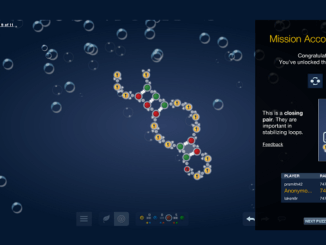
A recent article in Nature, titled ‘The hackers teaching old DNA sequencers new tricks’, describes how EteRNA researchers are hacking old DNA sequencers to reveal RNA secrets.
[…] For Stanford biophysicist Rhiju Das, such RNA arrays have served as platforms for identifying molecules that can diagnose active tuberculosis. The project began when a colleague discovered7 a signature of three RNAs that can distinguish between dormant and active tuberculosis. The challenge was to pinpoint a single molecule — a ‘riboswitch’ — that could actually identify which state the disease was in. Such a diagnostic molecule would have to be able to bind all three RNAs, plus a fluorescent reporter, and change shape depending on which ones were present. “It’s totally bananas, obviously,” Das says.To solve the puzzle, Das recruited the user-base of an online game he co-developed, called eterna. Players are tasked with designing RNAs that can fold in certain ways; the most promising structures get synthesized as part of a DNA-sequencing library, 10,000 at a time, and tested on the GAIIx chip. With 10,000 measurements per design, that’s about 100 million data points from each experiment — data that are fed back to the players to hone their skills. Over time, some users have become quite adept, Das says. “These players have now discovered principles that let them get perfect riboswitches, thermodynamically optimal riboswitches for a variety of test cases.”
And that includes the OpenTB Challenge. Over 3 rounds of game play, Das’s team has tested nearly 27,000 riboswitches from 187 players, identifying several that seem to fit the bill. One, submitted by a retired engineer in Falmouth, Massachusetts, looks like the floor plan of a castle in one state, and like an anchor in the other. Now, with funding from the Bill & Melinda Gates Foundation, Das plans to begin testing some of these designs for use as a pregnancy-test-like diagnostic for tuberculosis.
Read the full article on nature:
https://www.nature.com/articles/d41586-018-05769-8


